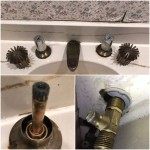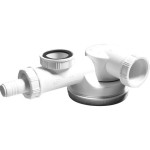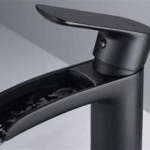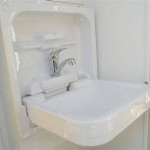How to Get Rid of Little Flies in Your Bathroom Sink
The persistent presence of small flies hovering around a bathroom sink can be a frustrating and unsanitary issue. These tiny insects, often mistaken for fruit flies, are typically drain flies, also known as moth flies or sewer gnats. Understanding their behavior and breeding habits is crucial for effective elimination. This article provides a comprehensive guide to identifying, eliminating, and preventing drain flies in a bathroom sink.
Drain flies are small, dark-colored insects with rounded wings that are covered in fuzzy hairs, giving them a moth-like appearance. They are attracted to moist environments and decaying organic matter, which makes drains and sewers ideal breeding grounds. These flies lay their eggs in the stagnant water and slime that accumulates inside drainpipes. The larvae feed on this organic material, contributing to the breakdown of waste and, unfortunately, perpetuating their life cycle within the plumbing system.
The life cycle of a drain fly is relatively short, typically lasting between two to three weeks. This rapid reproduction rate explains why a small infestation can quickly become a significant problem. Understanding this lifecycle is critical when implementing control measures, as targeting both adult flies and larvae is necessary for complete eradication.
The presence of drain flies is not only a nuisance but can also pose health concerns. While they do not typically bite humans, they can carry bacteria and germs picked up from the unsanitary environments where they breed. These bacteria can potentially contaminate surfaces and contribute to the spread of illness, making it vital to address the infestation promptly and thoroughly.
Identifying the Source of the Infestation
Pinpointing the exact source of the drain fly infestation is the first and most important step in eliminating them. While the bathroom sink drain is a common culprit, it's essential to consider other potential breeding grounds within the vicinity. Other possible sources include shower drains, overflowing toilets, leaky pipes, and even improperly maintained garbage disposals. Thoroughly inspecting these areas is crucial for a comprehensive solution.
A simple and effective method for locating the primary breeding site is the "tape test." This involves placing a piece of clear tape, sticky side down, over the drain opening in the evening. In the morning, inspect the tape for trapped flies. If flies are present on the tape, it confirms that the drain is indeed a breeding ground. Repeat this process on other potential drain sources to determine the extent of the infestation.
Another diagnostic method involves pouring a small amount of mineral oil down the drain. The mineral oil will coat the inside of the drainpipe, trapping any emerging flies. After a few hours, check the drain for dead flies. This method not only helps to identify the source but also provides a minor form of control by suffocating the adult flies.
Once the source is identified, a detailed inspection of the drain itself is necessary. This may involve using a flashlight to examine the inside of the drainpipe for signs of slime buildup and larval activity. In some cases, a plumber's snake or a drain camera may be required to access deeper sections of the drain and accurately assess the condition.
Effective Elimination Methods
Once the source of the drain fly infestation has been identified, a combination of methods can be employed to effectively eliminate both the adult flies and their larvae. These methods range from simple household remedies to more intensive cleaning procedures and, in some cases, professional intervention.
One of the most effective and environmentally friendly methods is to thoroughly clean the drain and remove the organic matter that serves as a breeding ground. This can be accomplished using a stiff brush, such as a bottle brush or a plumbing snake, to scrub the inside of the drainpipe. Focus on removing the slime and debris that accumulate along the walls of the pipe. Follow the scrubbing with a thorough flush of hot water to dislodge and remove any remaining material.
An alternative cleaning solution involves using a mixture of baking soda, vinegar, and boiling water. Pour one cup of baking soda down the drain, followed by one cup of vinegar. Allow the mixture to fizz and react for about 30 minutes. This chemical reaction helps to loosen and break down the organic matter. After 30 minutes, slowly pour a pot of boiling water down the drain to flush away the debris. This method may need to be repeated several times for optimal results.
It is crucial to avoid using harsh chemical drain cleaners containing bleach or strong acids. While these chemicals may kill some of the flies and larvae, they can also damage pipes and pose environmental hazards. Furthermore, they often fail to completely remove the organic matter, allowing the flies to return once the chemical residue dissipates. A more sustainable and environmentally responsible approach is to focus on manual cleaning and natural cleaning solutions.
In cases of severe infestations, a biological drain cleaner containing enzymes or bacteria may be more effective. These biological cleaners work by breaking down the organic matter that the drain flies rely on for food and breeding. They are generally safe for pipes and the environment, but it is important to follow the instructions carefully and allow sufficient time for the product to work.
For adult flies, a simple fly swatter or a sticky fly trap can be used to reduce their numbers. Commercial fly sprays can also be effective, but these should be used with caution, as they can contain harmful chemicals. Ensure proper ventilation when using fly sprays and avoid spraying directly into drains, as this can contaminate the water supply.
Preventing Future Infestations
Preventing future drain fly infestations requires implementing consistent hygiene practices and addressing underlying plumbing issues that contribute to their breeding environment. Regular cleaning of drains and maintaining a sanitary environment are crucial for preventing the return of these pests.
One of the most effective preventative measures is to regularly flush drains with hot water. This helps to prevent the accumulation of organic matter and slime that attracts drain flies. Aim to flush each drain at least once a week, especially those that are not frequently used.
Another preventative measure is to regularly clean the drain stoppers and screens. These components can trap hair, soap scum, and other debris that can contribute to the buildup of organic matter. Remove the stoppers and screens periodically and clean them thoroughly with a brush and soapy water.
Addressing any underlying plumbing issues, such as leaky pipes or clogged drains, is essential for preventing drain fly infestations. Leaky pipes create moist environments that are conducive to breeding, while clogged drains can trap organic matter and provide a food source for the larvae. Repair any leaks promptly and address any clogs as soon as they are detected.
Consider installing drain screens or mesh covers over drain openings to prevent adult flies from entering and laying eggs. These screens can also help to prevent hair and other debris from entering the drain, further reducing the buildup of organic matter.
Maintaining a clean and dry bathroom environment is also important. Wipe up any spills promptly and ensure adequate ventilation to prevent moisture buildup. Regularly clean the sink, countertops, and floor to remove any food particles or other organic matter that could attract drain flies.
Regular use of enzyme-based drain cleaners can help to prevent the accumulation of organic matter and maintain a healthy drainage system. These cleaners are safe for pipes and the environment, and they can effectively break down the food sources that drain flies rely on.
In cases where the infestation persists despite these preventative measures, it may be necessary to consult with a professional plumber or pest control service. They can conduct a thorough inspection of the plumbing system and identify any hidden breeding grounds or underlying issues that may be contributing to the problem. They can also provide more advanced treatment options, such as professional drain cleaning or insecticide applications, if necessary.
By diligently implementing these preventative measures, it is possible to create an environment that is less attractive to drain flies and significantly reduce the risk of future infestations. Consistent hygiene practices and proactive maintenance are key to maintaining a fly-free bathroom.

5 Easy Ways To Get Rid Of Drain Flies Fast

How To Get Rid Of Drain Flies

How To Get Rid Of Drain Flies Rt Olson Plumbing

How To Rid Of Drain Flies Forbes Home

How To Get Rid Of Drain Flies Moth And Prevent An Infestation Pest Defence

Are These Drain Flies Coming Out Of My Bathroom Drains
Jab Plumbing Solutions Blog Blocked Drain Plumbers

How To Get Rid Of Drain Flies 6 Easy Steps

Why Do I Have Drain Flies In My Property And How To Get Rid Of Them

Fruit Flies In The Bathroom Get Rid Of Them Michael S Plumbing Orlando







